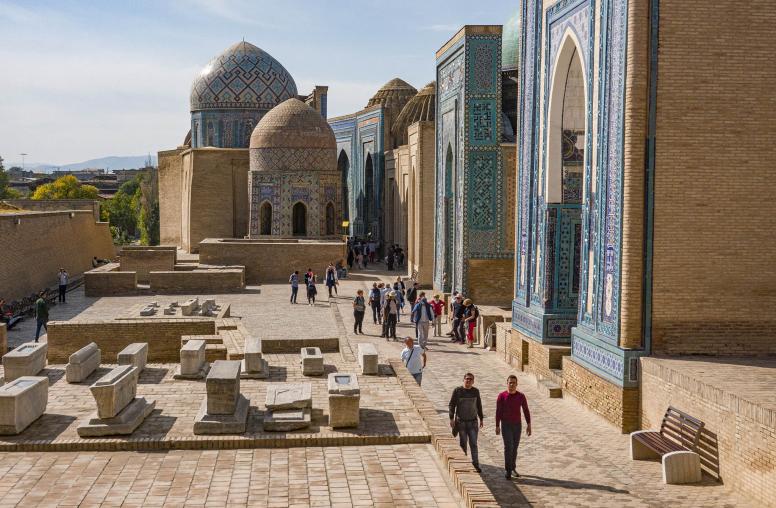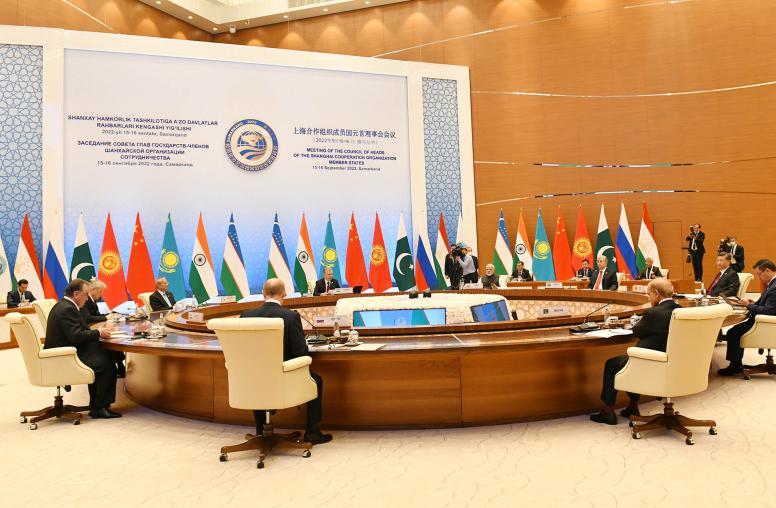Blinken Debuts New U.S. Approach in Central Asia
Amid strategic competition, the U.S. should help Central Asian states achieve balance in their foreign relations, not force them to pick sides.
U.S. Secretary of State Antony Blinken visited Kazakhstan and Uzbekistan this week, where he signaled that Washington is changing tack in the region. For nearly two decades, U.S. engagement in the region focused on how it could help Washington in Afghanistan. Following the Afghanistan withdrawal, U.S. policy in Central Asia should be more modest, focused on helping these countries achieve balance in their relations with each other and the outside world, particularly in an era of great power competition. After all, these countries are neighbors of Russia and China and can’t afford to choose sides.

Upgrading U.S. Engagement in the Region
In Astana, Blinken met with Central Asian foreign ministers and attended the first ministerial-level engagement of the C5+1 Diplomatic Platform — which represents U.S. engagement with Kazakhstan, Kyrgyzstan, Tajikistan, Turkmenistan and Uzbekistan — in the region since its 2015 founding. This demonstrates an important upgrade in the level of diplomatic engagement in Central Asia, which has received much less high-level attention now that Washington no longer needs Central Asian supply routes for the war in Afghanistan. The local press was happy to report that Blinken announced that local companies impacted by Western sanctions on Russia would be compensated by the United States.
Blinken’s visit is a timely refresh of the C5+1, which has remarkably survived through three very different administrations. While the context has changed — from the U.S. needing bases to support the war effort in Afghanistan, to preventing Central Asian fighters from joining ISIS, to assistance with its withdrawal — the Central Asian states are newly relevant in the era of great power competition.
Indeed, Blinken’s visit is especially significant considering that both Vladimir Putin of Russia and Xi Jinping of China have both recently traveled to the region. Despite the timing of the visit coinciding with the anniversary of the Russian invasion of Ukraine, that war was not the main focus of the public statements. If Afghanistan came up, it was likely more at the initiative of the Central Asians, who are now living next door to the Taliban.
Central Asia Amid Great Power Competition
Central Asian states see the benefit of having a great power friend in the United States that is powerful, but not a threat. Russia’s invasion of Ukraine has made the neighboring Central Asian States nervous about Russia’s role in the region. Moscow’s military presence in the region has severely declined amid the Ukraine war and raised concern in Central Asian capitals that have traditionally relied on Russian security guarantees and assistance. Economic sanctions on Russia threaten Central Asian trade and export, which is highly focused on transit through Russia, and also threaten the livelihoods of millions of Central Asian migrant workers who send billions of dollars home each year from Russia.
With the great powers focused on other priorities, Central Asia has also seen an increase in the role of regional middle powers, particularly Turkey, Iran and India. Turkey has formed its own regional “C4+1” Organization of Turkic States (excluding, for now, Farsi-speaking Tajikistan). Both Turkey and Iran have exported combat drones to the region and promised to produce them in Kyrgyzstan and Tajikistan (also along linguistic lines). India’s Prime Minister Narendra Modi held his own virtual C5+1 late last year as well. These countries have previously often deferred to Russian dominance in Central Asia, if only because they wanted to secure other things from Russia. Their increasing interest offers new options to Central Asian states.
The United States reputation, role, leverage and influence in the region have diminished since the Afghanistan withdrawal and the collapse of the U.S.-backed government in Kabul. With more limited policy options in the region, U.S. strategy needs to focus on ways to support the region’s independence in the new geopolitical context of 2023. Blinken’s trip is a step toward finding a new right-sized role for the United States in a post-Afghanistan war, post-Ukraine invasion world.
U.S. strategy in the region has long proclaimed support for the sovereignty, territorial integrity and independence of Central Asian states despite often prioritizing other parts of its strategic agenda. In the current context, with more a limited presence and leverage in the region, this means that the focus of U.S. policy should be on regionally based solutions to Central Asia’s security and socio-economic challenges. This includes helping the countries of the region work together as a group (what some in the region call “C5+0”) in which they are more united and stronger together.
The United States can help the countries of the region improve their position in the world by pursing two objectives, one external and one within the region.
Promoting Balanced Foreign Relations
The first objective of the C5+1 should be helping Central Asia connect with outside world through “multi-vector” engagements that include a more balanced connection to the global economy and community, and more equilibrium in these countries’ relationships with Russia and China. U.S. policy should:
- Help find alternative destinations for Central Asian labor migrants and seasonal workers — especially from Tajikistan, Kyrgyzstan and to a lesser extent Uzbekistan, who are all highly dependent on migrant labor remittances from Russia — in Europe, Japan, South Korea, Kazakhstan or other destinations.
- For a region now mostly surrounded by countries under international sanctions, help support increased economic integration and connectivity through the Caucasus, the Caspian Sea and Turkey, and support sanctions relief where possible for Central Asian countries.
- Consider including Azerbaijan, Turkey and Georgia in “C5+1” activities when called for, particularly on ways to export energy to Europe.
- Since Kazakhstan and Turkmenistan both depend heavily on export of hydrocarbons, help prepare Central Asian economies for energy transition away from fossil fuels exports in the medium-term future.
Building a Unified Regional Bloc
The second objective of the C5+1 should be helping the Central Asian states work with each other more as a unified regional bloc. Conflict and competition between Central Asian states weakens them all and creates opportunities for outside powers to exploit the contradictions between them. U.S. policy should:
- Respect the multi-vector foreign policy adopted by the Central Asian states. They must live as neighbors with Russia, China and their other immediate neighbors and have little say in changing the geopolitics, much less the geography, of the region. Pushing them to choose would be a mistake.
- Increase both the frequency and level of diplomatic engagement by the United States both bilaterally and in the context of C5+1. Blinken’s trip to the region is a great start.
- Encourage C5 states in taking a more substantial role in setting the agenda for C5+1, especially at the working level.
- Work toward more soft power engagement, including more educational exchanges, which would signal long-term commitment.
- Support cross-border community confidence and resource sharing in the region, especially around the disputed enclaves in the Ferghana Valley.
- Support regional media initiatives and the use of social media as a tool for positive change and community engagement across.
In the strategic context of 2023, the United States will necessarily be more focused on foreign policy priorities outside Central Asia. Washington’s role as a powerful, but distant and supportive friend to the region can help Central Asian countries achieve their stated goals of regional cooperation and a balanced, “multi-vector” relationship with the outside world.



